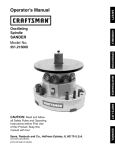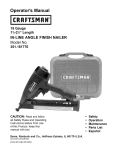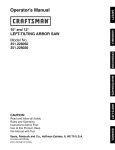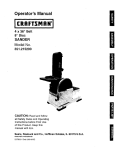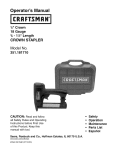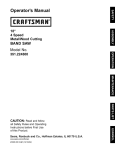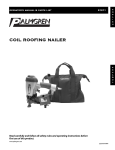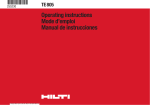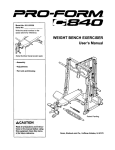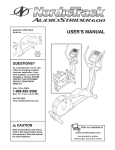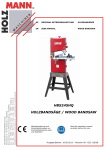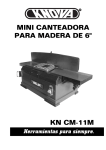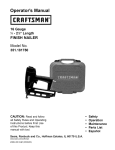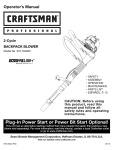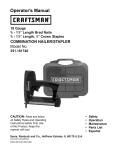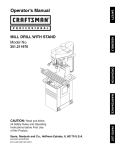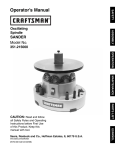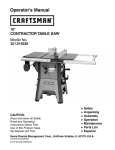Download Craftsman 351.182140 Operator`s manual
Transcript
Operator's Manual ® 11/4- 21/2" Length COIL UTILITY NAILER Model No. 351.182140 CAUTION: • • • • • Read and follow all Safety Rules and Operating Instructions before First Use of this Product. Keep this manual with tool. Sears, Roebuck and Co., Hoffman www.sears.com/craftsman 21662.00 Draft (01/12/04) Estates, IL 60179 U.S.A. Safety Operation Maintenance Parts List Espa5ol Warranty ......................................... 2 Safety Rules ...................................... 2 Operation ...................................... Maintenance ..................................... 3-6 6 Troubleshooting ................................... Parts Illustration and List .......................... 7 8-9 EspaSol ...................................... FULL * The tool must have a male, free-flow hose coupling so that all air pressure is removed from the tool when the coupling joint is disconnected. Failure to use proper coupling could cause accidental discharge, possibly causing injury. * Only use air hose that is rated for a maximum working pressure of 150 psi or 150% of the maximum system pressure, whichever is greater. Do not use a hose swivel connector with this tool. * * Do not pull trigger or depress contact trip while connecting to the air supply, as the tool may cycle, possibly causing injury. * When loading tool: Do not pull trigger or depress contact trip; Do not point the tool at yourself or others; Do not place hand or any part of body in the fastener discharge area of the tool as accidental actuation may occur and cause injury. * Disconnect tool from air supply before loading or unloading, performing tool maintenance, clearing a jammed fastener, leaving work area, moving tool to another location or handing the tool to another person. * Use Sears recommended * Do not load the tool until you are ready to use it. * Always assume that the tool contains fasteners. Keep the tool pointed away from yourself and others at all times. Never engage in horseplay. Never pull the trigger unless the contact trip is in contact with the workpiece. Keep others at a safe distance from the tool while the tool is in operation. * Always remove finger from trigger when not driving fasteners. Never carry the tool with finger on or under the trigger as accidental actuation may occur and cause injury. * Always keep hands and body away from the fastener discharge area when air supply is connected to the tool. Grip tool firmly to maintain control while allowing tool to recoil away from work surface as fastener is driven. If contact trip is allowed to recontact work surface before trigger is released, an unwanted fastener may be driven. * Check operation of the contact trip frequently. Never use the tool if the contact trip, trigger or springs have become inoperable, missing or damaged. Do not alter or remove contact trip, trigger or springs. Never use a tool that is leaking air, has missing or damaged parts, or requires repair. * Do not drive fasteners on top of other fasteners or with the tool at too steep an angle. The fasteners can ricochet and cause injury. Do not drive fasteners close to the edge of the workpiece. The workpiece is likely to split, allowing the fastener to fly free and cause injury. Do not attempt to drive fasteners into hard or brittle materials such as concrete, steel or tile. * Do not overreach. Always place yourself in a firmly balanced position when using or handling the tool. Do not attach the hose or tool to your body. * Do not operate tool without fasteners or damage to tool may result. Do not use tool without safety warning label. If label is missing, damaged or unreadable, contact SEARS to obtain a new label. 10-15 ONE YEAR WARRANTY If this product fails due to a defect in material or workmanship within one year from the date of purchase, Sears will at its option repair or replace it free of charge. Contact your nearest Sears Service Center (1-800-4-MY-HOME) to arrange for product repair, or return this product to place of purchase for replacement. If this product is used for commercial or rental purposes, this warranty will apply for 90 days from the date of purchase. This warranty applies only while this product is used in the United States. This warranty gives you specific legal rights, and you may also have other rights which vary from state to state. Sears, Roebuck and Co., Dept. 817WA, Hoffman Estates, IL 60179 * Read and follow all safety rules and operating instructions in this manual and on warning label of tool before using this tool. Keep this manual with the tool. * Keep work area clean and properly lighted. * Keep children, bystanders and visitors at a safe distance from work area while operating this tool. * Air tool operators and all others in work area should always wear safety goggles complying with United States ANSI Z87.1 to prevent eye injury from fasteners and flying debris when loading, operating and unloading this tool. Everyday eyeglasses have only impact resistant lenses. These are NOT safety glasses. ANSI Z87.1 safety glasses have permanently attached rigid, hard plastic side shields and will have "Z87.1" printed or stamped on them. * * Always wear ear protection. The work area may include exposure to excessive noise levels which will require necessary ear protection. Some environments will require head protection; use head protection conforming to ANSI Z89.1. Do not alter or modify this tool in any way. Do not use this tool for any application other than for which it was designed. fasteners only. * Do not use oxygen, carbon dioxide, high-pressure compressed gas or bottled gases as the power source for this tool. The tool will explode and serious personal injury could result. * * Only qualified repair personnel must perform tool service. * Never connect the tool to air pressure which could potentially exceed 200 psi. Use only clean, dry, regulated air within rated range as marked on tool. * * When servicing a tool, use only identical repair parts. Store tool out of reach of children and other untrained © Sears, Roebuck and Co. persons. 2 ° DESCRIPTION The Craftsman Coil Utility Nailer drives full head nails from 1_/4"to 2W' long. Magazine will hold a coil of 400 wire collated nails. Safety feature disables tool unless contact trip is pressed against workpiece. Sequential trigger switch allows selection of rapid-fire or single-fire mode. Contact trip can be adjusted for setting nail depth. Plastic protector on the end of contact trip prevents marring of workpiece. Air deflector can be adjusted to any direction. Die cast aluminum body with textured rubber grip minimizes operator fatigue and makes nailer lightweight and durable. The coil utility nailer is excellent for siding, sheathing, exterior trim, subflooring, decking and fencing. SPECIFICATIONS Capacity ..................... Nail size ....................... 400 wire collated coil nails 0.082 to .110" diameter Nail lengths ............................... Operating pressure ........................ Air inlet ................................... 1_ to 2_/2'' 65-110 PSI W' N.P.T. Length ....................................... 103/4 '' Height ....................................... Width .......................................... 11%" 5" Weight ..................................... All hoses and pipes in the air supply system must be clean and free of moisture and foreign particles. Hoses must be rated for a maximum working pressure of 150 PSI or 150% of maximum system pressure, whichever is greater. ° Do not mount swivel connector in air supply line. ° The air pressure should be properly regulated. ° Different workpiece materials and different fastener lengths will require different operating pressure. ° Be sure all connections in air supply system are sealed to prevent air loss. ° Never connect a female quick-disconnect coupling to the tool side of air line connection. A male, free-flow coupling should be connected to the tool side of air line connection (see Figure 1). WARNING: The female coupling provides a seal preventing loss of compressed air from compressor tank when disconnected from male coupling. If connected to tool side of air supply, the female coupling could seal a compressed air charge in the tool which could discharge if the tool trigger is actuated. I Male Connector 4.2 Ibs. NAILS 18081 (Box of 8000) ........... 18082 (Box of 6000) ............ AIR SUPPLY Galvanized nails, 13/4 '' long Galvanized nails, 2" long Female Connector LINE Refer to Figure 1. DANGER: De not use oxygen, carbon dioxide, high-pressure compressed gas or bottled gases as the power source for this tool. The tool will explode and serious personal injury could result. • The air tool operates on compressed 65 to 110 PSI. air at pressures from • Never connect the tool to air pressure which could potentially exceed 200 PSI. Use only clean, dry, regulated air within rated range as marked on tool. Air Delivery Required: 1.87 SCFM @ 90 PSI (30 shots per minute). WARNING: Keep hands and body away from discharge area of tool when connecting air supply. Always disconnect tool from air supply when servicing or adjusting tool and when tool is not in use. • Air operated tools require clean, dry, lubricated compressed air to ensure top performance, low maintenance and long life. • Dirt and abrasive materials present in all air lines will damage tool O-rings, valves and cylinders. Moisture will reduce tool performance and life if not removed from compressed air. A filter-regulator-lubricator system is required and should be located as close to tool as possible. A distance of less than 15 feet is recommended. • • • • Keep air filter clean. A dirty filter will reduce the air pressure to the tool causing a reduction in power and efficiency. The air supply system must be able to provide air pressure of 65 to 110 pounds per square inch at tool. Figure 1 - Air Supply Line LOADING Refer to Figures 2 through 6, (pages 3 and 4). WARNING: Disconnect tool from air supply. Do not load tool until you are ready to use it. Do not pull trigger or depress contact trip while loading tool. Always load with nose of tool pointing away from you and others. Always wear safety goggles that comply with United States ANSI Z87.1. NOTE: For best results, use Sears fasteners only. • Push the door latch down and swing the door open; then swing the magazine cover open (see Figure 2). Figure 2 - Opening the magazine ° The nail holder must be set to the length of the nails being used. Twist the spindle of the nail holder and position nail holder up or down so that the edge of the nail holder is aligned with the correct size indicator on the inside of the magazine. Twist spindle to lock nail holder in place (see Figure 3). Nail Heads Must be Positioned in This Slot CAUTION: Failure to adjust nail holder height may result in damage to advance mechanism. .... ,Second Nail Must Be Positioned in Feed Jaw Figure 5 - Load Nails into Feed Jaw ° Carefully close the magazine cover first. Then close the door and secure in position with the latch. Make sure the tab in the door holds the magazine cover in place (see Figure 6). \ Nail Holder Figure 3 - Adjust Nail Holder for Length of Nail ° Remove rubber band or tape holding nail coil. Place coil over the spindle of nail holder in magazine (see Figure 4). Figure 6 - Close the Magazine Cover and Door NAILING OPERATION Refer to Figures 7 through 10 (page 5). WARNING: Read and follow all safety rules and operating instructions in this manual and on warning label of tool before using this tool. Keep this manual with the tool. WARNING: Do not use this tool without safety warning label. If label is missing, damaged or unreadable, contact Sears to obtain a new label. Figure 4 - Load Coil into the Magazine WARNING: Never operate tool unless contact trip is in contact with workpiece. Do not operate tool without fasteners or damage to tool may result. Never fire fasteners into the air because fasteners may injure operator or others and damage to tool may result. Unwrap coil so that second nail can be placed between sides of feed jaw. The ram (Fig. 11, No. 20) may need to be pushed up to fit in the first nail. Make sure that the nail heads are positioned in the slot at the top of the nail feed rack (see Figure 5). ° 4 Perform "Safety Mechanism Check" as described in the Maintenance section (see page 6) prior to first use of tool and on a daily basis thereafter. • • The tool is equipped with to rapid-fire or single-fire switch is set to single-fire second fastener until the pulled again. CONTACT a rotating switch that can be set mode (see Figure 7). When the mode, the tool will not drive a trigger is fully released and When the switch is rotated to rapid-fire drive fasteners continuously. A fastener time the contact trip is pressed against long as the trigger is maintained in the TRIP ADJUSTMENT The contact trip may be adjusted up or down to vary the driven depth of the fastener. To adjust, rotate depth control knob (see Figure 8) to raise or lower contract trip to desired setting. mode, the tool can will be fired each the workpiece, as pulled position. Control Knob Figure 8 - Setting CONTACT • OPERATION: The air tool is equipped with a contact trip safety mechanism that disables tool unless contact trip is pushed against work. To drive a fastener hold body firmly and press contact trip on workpiece where fastener is to be applied. Pull trigger to drive fastener into workpiece. To fire a second fastener lift the tool from the workpiece, release the trigger and then repeat the above sequence. RAPID-FIRE • PAD STORAGE Pad can be removed and stored on the storage sleeve located on the magazine (see Figure 9). Figure 7 - Push and Rotate Switch to Select Operation Mode SINGLE-FIRE TRIP Depth Control OPERATION: The tool can also be operated by holding trigger depressed and pushing contact trip against workpiece. A fastener will be driven each time the contact trip is pushed against the workpiece. This operating procedure provides rapid-fire fastener driving. Never operate tool unless contact trip is in contact with workpiece. OPERATING Figure 9 - Storing Contact Trip Pad EXHAUST ° PRESSURE • Use only enough air pressure to perform the operation. Air pressure in excess of that which is required will make the operation inefficient and may cause premature wear or damage to the tool. • Determine minimum air pressure required by driving some test fasteners into the workpiece. Set air pressure so that test fasteners are driven down flush with the work surface. Fasteners driven too deep may damage workpiece. DEFLECTOR Exhaust deflector can be positioned to point in any direction (full 360 ° movement). Reposition deflector by grasping firmly and rotating to the desired position (see Figure 10). Exhaust Deflector. WARNING: All air power fastening tools recoil when operated. This recoil is caused by rapid driving of the fastener. Tool may bounce from recoil causing a second unwanted fastener to be driven. Reduce tool bounce by holding tool firmly in hand and pressing tool gently against workpiece. Let the tool do the work. This will allow recoil of tool to bounce tool away from workpiece preventing the driving of second fastener. Figure 10- Exhaust Deflector Adjustment 5 COLD WEATHER OPERATION CAUTION: Do not store in cold environment. Frost or ice could form inside tool affecting operation and damaging tool. Use a cold temperature lubricant, such as ethylene glycol, when operating tool in freezing temperatures. Refer to Figure 11. LUBRICATION Lubricate tool daily with quality air tool oil. If no air line lubricator is used, place five or six drops of oil into air inlet cap (Figure 11, Key No. 27) of tool everyday. MAGAZINE • AND PISTON-RAM Keep magazine and nose of tool clean and free of any dirt, lint or abrasive particles. The tip of the ram (Figure 11, Key No. 20) can become dented or rounded over time. • Square off the tip of the ram with a clean, fine hand file to extend the life of the ram and tool. Fastener firing will be more consistent if the ram tip is kept clean and square. SAFETY MECHANISM CHECK Inspect contact trip safety mechanism daily for proper operation. Do not operate tool if mechanism is not operating properly. With the red push-button switch in the rapid-fire mode, perform the following procedures to test safety mechanism: • Leave trigger untouched while pushing contact trip into workpiece. Tool must not fire. • Pull trigger while contact trip is clear of work and pointed away from operator and others. Tool must not fire. • Depress and hold trigger. Push contact trip against work where fastener is needed. The tool should drive only one fastener each time the contact trip is pushed against workpiece. If contact trip mechanism does not operate properly, repair tool immediately through Sears Service Center. Replace any damaged or missing parts. Use the parts list to order parts. REBUILD KITS Rebuild kits are available as spare parts, (see page 9). Tools should be rebuilt if tool fails to operate properly after extended use. See troubleshooting to determine required replacement parts. Disconnect tool from air supply or adjustment. before attempting repair NOTE: When replacing O-rings or cylinder, lubricate with grease before assembly. 6 SYMPTOM POSSIBLE CAUSE(S) CORRECTIVE ACTION Trigger cap leaks air 1. O-ring damaged 2. O-rings damaged 1. Check and replace damaged O-ring (Fig. 11, No. 30) 2. Check and replace damaged O-rings (Fig. 11, Nos. 30, 32, 34, 37, 56 and 105) Cap leaks air 1. Cap bolts loose 2. Damaged cap gasket 1. Tighten bolts (Fig. 11, No. 5) 2. Check and replace damaged gasket (Fig. 11, No. 9) Nose leaks air 1. Damaged nose O-ring 2. Damaged bumper 3. Nose bolts loose 1. Check and replace damaged nose O-ring (Fig.11, No. 64) 2. Check and replace damaged bumper (Fig. 11, No. 24) 3. Tighten bolts (Fig. 11, No. 79) Tool will net operate 1. Insufficient air supply 2. Damaged or worn head valve O-rings or seal 3. Damaged head valve spring 4. Head valve binding in cap 1. Check air supply 2. Replace damaged or worn seal or O-rings (Fig. 11, Nes. 10, 12 and 15) 3. Replace damaged spring (Fig. 11, No. 11) 4. Clean and lubricate cap and head valve (Fig. 11, Nos. 4 and 14) 5. Place five or six drops of air tool oil into air inlet cap (Fig. 11, No. 27) 5. Insufficient lubrication Tool operates slowly or loses power 1. Damaged head valve spring 2. Damaged or worn O-rings 3. Damaged trigger assembly 4. Build-up on ram 5. Cylinder not sealed on bumper properly 6. Insufficient air supply 7. Insufficient lubrication 8. Head valve poorly lubricated Tool skips fasteners or inconsistent operation 1. Feed piston not lubricated 2. Damaged feed piston O-rings 3. Jaws and/or pawls binding 4. Nail holder improperly adjusted 5. Defective coil nails, welded wires on coil breaking 6. Worn or damaged bumper 7. Build-up on ram or nose 8. Insufficient air supply 9. Damaged or worn piston O-ring 10. Insufficient lubrication 11. Fasteners too short 1. Check and replace damaged spring (Fig. 11, No. 11) 2. Replace damaged or worn O-rings (Fig. 11, Nos. 12 and 15) 3. Check and replace trigger assembly 4. Clean and lubricate piston/ram assembly (Fig. 11, No. 20) 5. Disassemble cylinder and assemble properly 6. Check air supply 7. Place five or six drops of air tool oil into air inlet cap (Fig. 11, No. 27) 8. Disassemble head valve (Fig. 11, No. 14), clean, lubricate, and assemble properly 1. Lubricate feed piston (Fig. 11, No. 67) with air tool oil 2. Check and replace damaged O-rings (Fig. 11, Nos. 12 and 32) 3. Check jaw and pawls (Fig. 11, Nos. 72, 81 and 83) operation. Clean and lubricate jaw/pawls Replace worn er damaged jaw/pawls 4. Adjust nail holder height properly (refer to Figure 3, page 4) 5. Discard defective nails 6. 7. 8. 9. 10. 12. Damaged fasteners 11. 12. 13. Incorrect fastener size 14. Head valve O-rings leak 13. 14. 15. Damaged trigger valve O-rings 15. 16. Bent or damaged ram 16. 17. Dirty magazine 18. Damaged or worn magazine 17. 18. Check and replace bumper (Fig. 11, No. 24) Clean and lubricate piston/ram assembly (Fig. 10, No. 20) Check air supply Check and replace O-ring (Fig. 11, No. 19) Place five or six drops of air tool oil into air inlet cap (Fig. 11, No. 27) Use Sears recommended fasteners only Discard damaged fasteners and use Sears recommended fasteners only Use Sears recommended fasteners only Check and replace damaged O-rings (Fig. 11, Nos. 12 and 15) Check and replace damaged O-rings (Fig. 11, Nos. 30, 32, 34, 37, 56 and 105) Check and replace damaged piston/ram assembly (Fig. 11, No. 20) Clean magazine and lubricate with air tool oil Check and replace magazine Model 351.182140 Figure 11 - Replacement Parts Illustration ./" // For Coil Utility Nailer 18 0 _ 19 27 23 26 \ 25 _1Ol 44 4o! 45 99 "101 102 88 / 84 / 89 98 KEY NO. PART NO. DESCRIPTION 1 2 3 4 5 6 7 8 9 10 11 12 13 14 15 16 17 18 19 20 21 22 23 24 25 26 27 28 29 30 31 32 33 34 35 36 37 38 39 40 41 42 43 44 45 46 47 48 49 50 51 52 53 54 STD870512 21587.00 21588.00 21589.00 STD870525 STD852005 21590.00 01210.00 21591.00 21592.00 21593.00 16249.00 21594.00 21595.00 21596.00 21597.00 07476.00 21598.00 04360.00 21599.00 08775.00 21600.00 21601.00 21602.00 N/A 07426.00 21044.00 21603.00 21604.00 16767.00 21605.00 06136.00 21606.00 04327.00 21607.00 21608.00 16331.00 21609.00 01873.00 17434.00 21610.00 21611.00 09622.00 06388.00 21612.00 21614.00 21613.00 21616.00 21617.00 21618.00 21619.00 21620.00 21621.00 21622.00 5-0.8 x 12mm Socket Head Bolt* Retainer Deflector * A QTY. Cap Cover 5-0.8 x 25mm Socket Head Bolt* 5mm Lock Washer* Cap 5-0.8 x 5mm Set Screw Gasket Seal Spring 20.8 x 2.4mm O-Ring Spacer Head Valve 44.7 x 3.5mm O-Ring Collar 70.5 x 2.0mm O-Ring Seal Ring 35.5 x 2.0mm O-Ring Piston Ram Assembly 45.5 x 2.0mm O-Ring Cylinder 45.7 x 3.5mm O-Ring Bumper Body 45.7 x 2.62mm O-Ring Air Inlet Cap 17.12 x 2.62mm O-Ring Trigger Head Valve 15.5 x 1.5mm O-Ring O-Ring 8.8 x 1.9ram O-Ring Valve Plunger 9.8 x 1.9mm O-Ring Spring Plunger 1.42 x 1.53mm O-Ring Trigger Cap 3 x 22mm Spring Pin 3 x 30mm Spring Pin Throttle Spring 1/8" Steel Ball 3CMI-4 E-Ring Spring Contact Trip Guide Spring Spring Guide Knob 2.0 x 14mm Spring Pin Spring Detent Ring Set Ring 2.6 x 1.2mm O-Ring 1 1 1 1 4 4 1 1 1 1 1 2 1 1 1 1 1 1 1 1 1 1 1 1 1 1 1 1 1 1 2 2 1 1 1 1 1 1 1 3 1 1 1 1 1 1 1 1 1 1 1 1 1 1 Accessories Qty./Box NO. Galvanized Nails, 13/4"long 8000 9-18081 A Galvanized 6000 9-18082 DESCRIPTION QTY. 21623.00 21624.00 21625.00 21626.00 06384.00 21627.00 21628.00 Depth Screw 9.0 x 2.0mm O-Ring Contact Trip Cover Contact Trip 3CMI-3 E-Ring Trigger Assembly Rubber Pad 1 1 1 1 1 1 1 62 63 64 65 66 67 21629.00 21630.00 06909.00 06064.00 21631.00 21632.00 Contact Trip Pad Bushing 44.17 x 1.78ram O-Ring 3.8 x 1.9mm O-Ring Nose Feed Piston 1 1 1 1 1 1 68 69 70 21633.00 21634.00 21635.00 Spring Feed Piston Bumper Feed Piston Cover 1 1 1 71 72 73 06131.00 21636.00 15401.00 3BMI-28 Retaining Ring Feed Jaw 4 x 22ram Dowel Pin 1 1 1 74 75 76 21637.00 21638.00 21639.00 Spring Driver Driver Pin 1 1 1 77 78 79 80 21640.00 STD852006 STD870620 21641.00 2.57 x 1.78mm O-Ring 6mm Lock Washer* 6-1.0 x 20ram Socket Head Bolt* Door 1 4 4 1 81 82 83 84 85 86 21642.00 21643.00 21644.00 21645.00 21646.00 21647.00 Upper Retaining Pawl Spring Lower Retaining Pawl Spring Spring Door Latch 1 1 1 1 1 1 87 88 89 90 21648.00 21649.00 STD870412 21650.00 2.84 x 2.62mm O-Ring Door Cover 4-0.7 x 12ram Socket Head Bolt* Door Pivot Pin 1 1 2 1 91 92 93 94 21651.00 21652.00 21653.00 21654.00 Magazine Spring Adjusting Post Nail Holder 1 1 1 1 95 96 97 98 09033.00 21655.00 21656.00 21657.00 2.5 x 12ram Spring Pin Clip Cap Pin 1 1 1 2 99 100 101 21658.00 STD870520 STD843508 2.8 x 1.9mm O-Ring 5-0.8 x 20ram Socket Head Bolt* 5mm Fiber Hex Nut* 3 2 2 102 103 104 21659.00 21660.00 21661.00 Magazine Cover Magazine Spacer Guard 1 1 1 105 A A A 21850.00 21710.00 21663.00 21662.00 3.5 x 1.5mm O-Ring Warning Label Storage Case Operator's Manual 1 1 1 1 Kits A 21704.00 A 21705.00 Trigger Rebuild Kit Fig. 11, Nos. 30, 32, 34, 35, 36 37, 56 and 105 Head Valve Rebuild Kit 21706.00 Fig. 11, Nos. 9, 11, 12 and 15 Piston-Ram Rebuild Kit Model No. A Nails, 2" long PART 55 56 57 58 59 60 61 Rebuild Standard hardware item available locally Not Shown Recommended KEY NO. A 1 1 1 Fig. 11, Nos. 9, 18, 19 and 20 A A 21707.00 21708.00 Cylinder Rebuild Kit Fig. 11, Nos. 9, 21,23 Feed Piston Rebuild 1 and 24 Kit Fig. 11, Nos. 12, 32, 67 and 69 1 lth - 272" de Iongitud CLAVADORA DE CARRETE DE USO PRACTICO • Modelo No. 351 •182140 • permanentes rigidas, impreso o estampado • ............................................. y Lista de Partes ............................ Operaci6n Mantenimiento Identificaci6n No utilice de carbono, COMPLETA Si fallara este producto 14 15 • DE UN ANO por causa de defectos en el material al establecimiento donde La herramienta Qnicamente se utiliza Utilice Linicamente presi6n de trabajo • Hoffman vez. Mantenga Mantenga iluminada. el Area de trabajo en • • Los operadores de herramientas neumaticas y todas las demas personas presentes en el Area de trabajo deben usar siempre gafas de seguridad que cumplan con los requisitos producirse la herramienta una activaci6n del abastecimiento accidental y de aire antes la herramienta a otra ubicaci6n a otra persona. Use Linicamente los sujetadores la herramienta o entregarle la Sears recomendados. No cargue Asuma siempre que la herramienta Mantenga la herramienta apuntada hasta que este listo para usarla. contiene sujetadores. en direcci6n contraria a usted y a otras personas en todo momento. Nunca juegue con la herramienta. Nunca oprima el gatillo a menos que el disparo por contacto haya entrado en contacto con la pieza de trabajo. Mantenga a toda persona a una distancia prudente de la herramienta mientras se encuentra en funcionamiento. Aleje siempre los dedos del gatillo cuando no impulse sujetadores. Nunca transporte la herramienta con el dedo en el gatillo o debajo de este ya que puede ocurrir accidental y ocasionar lesiones. • Mantenga siempre las manos y el cuerpo descarga de sujetadores de aire a la herramienta. una activaci6n alejados del Area de cuando se conecte un abastecimiento Agarre la herramienta firmemente para mantener el control a la vez que le permite rebotar lejos de la superficie de trabajo cuando se impulsan los sujetadores. Si se permite que el disparo por contacto vuelva a hacer con- de la norma estadounidense ANSI Z87.1, para evitar lesiones oculares ocasionadas por sujetadores y parficulas que salgan disparadas al cargar, operar y descargar esta herramienta. Los anteojos comunes tienen lentes que s61o son resistentes al impacto. NO son anteojos de seguridad. Las gafas de con protecciones No oprima el gatillo ni presione • limpia y adecuadamente cuentan lesiones. • junto con la herramienta. Mantenga a los niffos, a los visitantes y a toda otra persona a una distancia prudente del Area de trabajo mientras hace funcionar esta herramienta. Desconecte jo, trasladar herramienta • ANSI Z87.1 con esta herramienta. de cargar o descargar, realizar el mantenimiento de la herramienta, desatascar un sujetador, abandonar el Area de traba- Estates, • seguridad ocasionar Cuando cargue la herramienta: tadores ya que podrfa ocasionar lesiones. • este manual Io cual sea mayor. el disparo por contacto; No apunte la herramienta hacia usted mismo o hacia otras personas; No coloque las manos ni ninguna parte de su cuerpo en el Area de descarga de suje- Lea y siga todas las reglas de seguridad e instrucciones de operaci6n incluidas en este manual yen la etiqueta de advertencia de la herramienta antes de utilizar este producto por primera • and Co., Dept. 817WA, una manguera de aire clasificada para una maximo de 1034 kPa o 150% de la presi6n del sistema, cicla y podrfa • Esta garantfa le otorga derechos legales especfficos y tambien puede usted tener otros derechos que varfen de estado a estado. Sears, Roebuck IL 60179 para No oprima el gatillo ni presione el disparo por contacto mientras conecta el abastecimiento de aire, ya que la herramienta Io adquiri6. si el producto debe contar con un acoplamiento No use un conector giratorio de manguera Si este producto se usa para fines comerciales o de alquiler, esta garanfia es valida por 90 dias a partir de la fecha de compra. Esta garantfa es aplicable los Estados Unidos. de • elecci6n, sin costo adicional. Solicite al Centro de Servicio Sears (1-800-4-MY-HOME) mas cercano la reparaci6n del o devuelvalo gas comprimido • o en la mano de obra en un lapso de un afro a partir de la fecha de compra, Sears Io reparara o reemplazar& a su producto di6xido a la Nunca conecte la herramienta a una presi6n de aire que pudiera exceder 1379 kPa. Utilice Linicamente aire regulado, maxima GARANTIA oxfgeno, manera. diferente conecte la junta del acoplamiento. El uso de un acoplamiento incorrecto podffa generar una descarga accidental y posiblemente ocasionar lesiones. 11-14 ............................ de ninguna para una aplicaci6n manguera macho de fiujo libre de manera que la presi6n del aire pueda removerse de la herramienta cuando se des- 10-11 ....................................... de Problemas • 10 ............................... esta herramienta No utilice esta herramienta que fue diseffada. limpio y seco que se encuentre dentro de la gama de capacidad nominal indicada en la herramienta. 8-9 ........................................ No altere ni modifique ducir graves lesiones. 2-7 Garanfia ............................................ Reglas de Seguridad Utilice siempre protecci6n para los ofdos. El Area de trabajo podrfa estar expuesta a niveles de ruido excesivos los cuales alta presi6n o gas embotellado como fuentes de alimentaci6n para esta herramienta. La herramienta podrfa estallar y pro- • Ilustraci6n y tendran haran necesario la utilizaci6n de protecci6n para los ofdos. Algunos entornos requeriran protecci6n para la cabeza; utilice protecci6n para la cabeza conforme a ANSI Z89.1. PRECAUClON: Lea y siga todas las Reglas de Seguridad y las Instrucciones de Operaci6n antes de usar este producto por primera vez. Ingles de plastico endurecido, el c6digo "Z87.1". tacto con la superficie de trabajo antes de soltarse el gatillo, podrfa producirse el impulso no deseado de un sujetador. laterales 10 • Verifique con frecuencia el funcionamiento del disparo por contacto. Nunca utilice la herramienta si el disparo por con- LINEA Consulte tacto, el gatillo o los resortes no funcionan, faltan o estan daffados. No altere ni extraiga el disparo por contacto, el gatiIio o los resortes. Nunca utilice una herramienta que tenga una fuga de aire, partes da_adas o que falten, o que necesite ser reparada. • mentaci6n y producir • No impulse sujetadores sobre otros sujetadores o con la herramienta a un angulo demasiado inclinado. Los sujetadores pueden rebotar y ocasionar lesiones. No impulse sujetadores cerca del borde de la pieza de trabajo. La pieza de trabajo podrfa partirse, permitiendo que el sujetador salga disparado y La herramienta • Suministro a su cuerpo. • No utilice la herramienta si la misma no incluye la etiqueta de advertencia de seguridad. Si la etiqueta falta, esta daffada o es ilegible, comunfquese con SEARS para adquirir una etiqueta nueva. El servicio de mantenimiento lizado Linicamente ya que podffa de la herramienta por personal de reparaci6n • Cuando le haga el servicio a la herramienta, mente partes de reparaci6n id@nticas. • Almacene la herramienta fuera del alcance personas que no hart recibido capacitaci6n • a 621 kPa Mantenga las manos y el cuerpo de la herramienta cuando conecte alejados del el abaste- Las herramientas neumAticas requieren aire comprimido lubricado, seco y limpio para asegurar un rendimiento 6ptimo, de los niffos y de para su uso. bajo y larga vida t3til. • El polvo y los materiales abrasivos presentes lineas de aire provocaran dahos a los anillos los cilindros. • La humedad reducirb, el rendimiento y la vida Litil de la herramienta si no se remueve del aire comprimido. • Se necesita un sistema de filtro-regulador-lubricador, el cual debera colocarse Io mb.s cerca posible de la herramienta. Se utilice Linica- Craftsman 1.87 SCFM por minuto). recomienda de uso practice a pre- de Aire Necesario: mantenimiento debe ser reacualificado. • de carrete neum_.tica opera con aire comprimido cimiento de aire. Desconecte siempre la herramienta del abastecimiento de aire cuando le haga mantenimiento o ajustes y cuando la herramienta no se est@ usando. DESCRIPClON La Clavadora estallar do, limpio y seco que se encuentre dentro de la gama de capacidad nominal indicada en la herramienta. ADVERTENClA: Area de descarga la herramienta sin los sujetadores dahos a la misma. podffa Nunca conecte la herramienta a presi6n de aire que pudiera exceder 1379 kPa (200 PSi). Utilice t3nicamente aire regula- mienta. No sujete la manguera No opere ocasionar La herramienta siones de 448 a 758 kPa (85 a 110 PSI). (30 disparos ni la herramienta 1 en la p6.gina 12. para esta herramienta. graves lesiones. No trate de alcanzar demasiado lejos. Parese siempre en una posici6n firme y equilibrada cuando use o maneje la herra- • • la Figura DE AIRE PELIGRO: No utilice oxigeno, di6xido de carbono, gas comprimido de alta presi6n o gas embotellado como fuentes de ali- ocasione lesiones. No intente impulsar sujetadores en materiales duros o quebradizos tales como concreto, acero o Ioza. • DE ABASTECIMIENTO impulsa una distancia en todas las O, las vb.lvulas y menor de 4.6 metros (15 pies). Mantenga el filtro de aire limpio. Un filtro sucio reducirb, la presi6n de aire de la herramienta, Io cual disminuira la potenciay eficiencia de la misma. clavos de cabeza completa de 1 ¼ a 2 F2 pulgada de largo. El dep6sito sujeta un carrete de 400 clavos intercalados para alam- • bre. El mecanismo de seguridad inhabilita la herramienta a menos que el disparo por contacto est@ presionado contra la El sistema de abastecimiento de aire debera proporcionar presi6n de aire de 448 a 758 kPa (65 a 110 PSI). • Todas las mangueras pieza de trabajo. El interruptor de gatillo secuencial permite la selecci6n del modo de disparo rdtpido o del modo de disparo sencillo. El disparo por contacto puede ajustarse para regular profundidad del clavo. El protector pl_.stico en el extremo del y tubeffas del sistema la para una presi6n de trabajo maximo de 1034 kPa o 150% de la presi6n maxima del sistema, Io cual sea mayor. disparo por contacto evita que se dave la pieza de trabajo. El desviador de escape puede ajustarse en cualquier direcci6n. El • No monte el conector de aire. cuerpo de aluminio fundido a presi6n con agarre de caucho texturizado reduce la fatiga del operador y hace de la clavadora • La presi6n de aire debe regularse • Diferentes materiales una herramienta liviana y duradera. La Clavadora de carrete uso practico es ideal para tablas de forro para paredes, revestimientos, bordes exteriores, substratos, revestimientos cubiertas de gos de sujetadores operaci6n. de y cercados. • ESPEClFICAClONES Capacidad Tamaffo .... del clavo Longitudes AsegLirese ................ del clavo ........................... Presi6n de operaci6n Entrada de aire ................................ ............ Longitud ........................................ AItura ........................................... Ancho ............................................. Peso .................................. intercalados • para alambre 0.082 to .110" de diametro PSI) 103/4', 115/8" ................. diferentes selladas presiones lar- de en el sistema de aire para evitar la p@rdida de aire. 1, pagina 12). sor cuando se encuentre desconectado del acoplamiento macho. Si se encuentra conectado al lado del abastecimiento de aire de 5" la herramienta, el acoplamiento hembra podria sellar una carga de aire comprimido en la herramienta, la cual podffa a su vez 1.90 kg (4.2 Ibs.) Clavos galvanizados, 13/4 " de largo 18082 (Caja de 6000) requerirb.n ADVERTENClA: El acoplamiento hembra proporciona un sello que evita la p@rdida de aire comprimido del tanque del compre- descargarse ................. adecuadamente. de la pieza de trabajo y diferentes Nunca conecte un acoplamiento de desconexi6n rapida hembra en el lado de conexi6n de la linea de aire de la herra- la Figura W' N.RT. CLAVOS 18081 (Caja de 8000) en la linea de abastecimiento mienta. Conecte un acoplamiento macho de fiujo libre en el lado de conexi6n de la linea de aire de la herramienta (v@ase 1% a 2W' 448 a 758 kPa (65-110 giratorio de que todas las conexiones se encuentren 400 clavos en carrete de abastecimien- to de aire deber,_n estar limpias y libres de humedad y parficulas extrahas. Las mangueras deben estar clasificadas Clavos galvanizados, 2" de largo 11 si se activa el gatillo de la herramienta. Conector macho \ Conector hembra Figura 1 - Linea de Abastecimiento de Aire Sujetador de Clavos CARGA Consulte las Figuras 2 a la 6 (paginas ADVERTENClA: Desconecte to de aire. No cargue la herramienta Figura 3 - Ajuste del Sujetador de Clavos a la Longitud los Clavos 12 y 13). la herramienta del abastecimien- hasta que este listo para • usarla. No oprima el gatillo o presione el disparo pot contacto mientras carga la herramienta. Siempre cargue la herramienta de Extraiga la banda de goma o la cinta que sujeta el carrete de clavos. Coloque el carrete sobre el husillo del sujetador de clavos en el dep6sito (vease la Figura 4). con la oreja apuntada en direcci6n contraria a usted y a otras personas. PSngase siempre gafas de seguridad que cumplan con la norma ANSI Z87.1 de los Estados Unidos. AVlSO: tadores • Para obtener Sears. Empuje mejores resultados, el pestillo de la puerta utilice Qnicamente suje- hacia abajo y gire la puerta para abrirla; luego gire la cubierta (vease la Figura 2). del dep6sito para abrirla Figura 4 - Cargue el Carrete en el Deposito Desenrolle el carrete de manera que el segundo clavo pueda colocarse entre los lados de la mordaza de avance. Quizas sea necesario 8) para poder empujar el ariete (Fig. 11, No. 20 en la p_.gina colocar el primer clavo. AsegOrese que las cabezas de los clavos queden parte superior de la cremallera Figura 5). Figura 2 - Abriendo el Deposito • ubicadas en la ranura de la de avance de clavos (vease la El sujetador de clavos debera estar ajustado a la misma Iongitud de los clavos que se utilizaran. Gire el husillo del sujetador de clavos y coloque este hacia arriba o hacia abajo de manera que el borde del sujetador de clavos quede alineado con el indicador de tamaSo correcto en la superficie interior del dep6sito. Gire el husillo para asegurar el sujetador de clavos en su posici6n (vease la Figura 3). PREOAUOION: Si no ajusta la altura del sujetador de clavos podrfa ocasionar dafios al mecanismo de avance. El segundo clavo debe colocarse en la mordaza de avance Figura 5 - Cargue los Clavos en la Mordaza de Avance 12 Cierre primero con cuidado la tapa del dep6sito. Luego cierre la puerta y asegLirela en su posici6n con el pestillo. Aseg@ese que la lengQeta en la puerta sostenga la tapa del dep6sito en su posici6n (vease la Figura 6). Figura 7 - Presione y Gire el Interruptor para Seleccionar el Modo de Operacion Figura 6 - Cierre la Tapa del Deposito y la Puerta OPERACION Consulte OPERACION DE CLAVADO las Figuras 7 a la 10 (paginas • 13 y 14). DE DISPARO UNICO: La herramienta neumatica esta equipada con un mecanismo de seguridad de disparo por contacto que inhabilita la herra- ADVERTENClA: Lea y siga todas las reglas de seguridad e instrucciones de operaci6n incluidas en este manual yen la eti- mienta a menos que el disparo por contacto este presionado contra la pieza de trabajo. Para impulsar el sujetador sostenga queta de advertencia de la herramienta antes de utilizar este producto pot primera vez. Mantenga este manual junto con la herramienta. el cuerpo firmemente y presione el disparo pot contacto contra la pieza de trabajo donde deba aplicarse el sujetador. Optima ADVERTENClA: No utilice esta herramienta si la misma el gatillo para impulsar el sujetador en la pieza de trabajo. Para impulsar un segundo sujetador, levante la herramienta de la no incluye la etiqueta de advertencia de seguridad. Si la etiqueta falta, esta daSada o es ilegible, comunfquese con Sears para adquirir una etiqueta pieza de trabajo, suelte el gatillo y luego repita la secuencia anterior. nueva. OPERAClON ADVERTENClA: Nunca opere la herramienta a menos que el disparo por contacto haya entrado en contacto con la pieza de • • • PRESlON • sujetando el gatillo DE OPERAClON Use s61o presi6n de aire suficiente para realizar la operaci6n. El exceso de presi6n de aire data como resultado una operaci6n ineficiente y podrfa ocasionar el desgaste o dafio La herramienta viene equipada con un interruptor giratorio que puede ajustarse a modo de disparo rapido o a modo de disparo 0nico (vease la Figura 7). Cuando se ajusta el interruptor prematuro • de la herramienta. Determine la presi6n de aire mfnima requerida impulsando algunos sujetadores de prueba en la pieza de trabajo. Ajuste la presi6n de aire de manera que los sujetadores de prueba sean impulsados al ras de la superficie de trabajo. Los sujetadores impulsados de manera demasiado profunda podrian Cuando se rota el interruptor al modo de disparo rapido, la herramienta puede impulsar sujetadores de manera continua. da_ar la pieza de trabajo. Se disparara un sujetador cada vez que el disparo por contacto se presione contra la pieza de trabajo, siempre y cuando el en la posici6n ademas Nunca opere la herramienta a menos que el disparo por contacto haya entrado en contacto con la pieza de trabajo. Realice la "Verificaci6n del Mecanismo de Seguridad" tal como se describe en la secci6n Mantenimiento (vease la pagina 14) antes de utilizar la herramienta por primera y luego diariamente. gatillo se mantenga puede operarse sione el disparo por contacto contra la superficie de trabajo. Este procedimiento brinda un impulso rapido del sujetador. y a otras per- en el modo de disparo 0nico, la herramienta no impulsara un segundo sujetador hasta que se suelte el gatillo por completo y se vuelva a tirar de 51. • La herramienta RAPIDO: oprimido y presionando el disparo por contacto contra la pieza de trabajo. Se impulsara un sujetador cada vez que se pre- trabajo. No opere la herramienta sin los sujetaclores ya que podria ocasionar daSos a la misma. Nunca dispare sujetadores en el aire porque podrian lesionar al operador sonas, y ocasionar dafios a la herramienta. DE DISPARO ABVERTENClA: Todas las maquinas herramientas neumaticas de sujeci6n retroceden durante la operaci6n. Este retroceso es de tiro. producido por la rapida impulsi6n del sujetador. La herramienta podrfa rebotar debido al retroceso y ocasionar el impulso no deseado de un segundo sujetador. mienta sujetando esta firmemente Reduzca el rebote de la herracon la mano y presionandola suavemente contra la pieza de trabajo. Deje que la herramienta haga el trabajo. Esto har_t que el retroceso de la herramienta rebote la herramienta lejos de la pieza de trabajo y evitara la impulsi6n de un segundo sujetador. 13 AJUSTE El disparo DEL DISPARO por contacto POR CONTACTO puede ajustarse OPERAClON hacia arriba EN CLIMAS PRECAUClON: o hacia FRIOS No Io almacene en un ambiente frfo. La escar- abajo para variar la profundidad del sujetador en la pieza de trabajo. Para ajustarlo, gire la perilla de control de profundidad cha o el hielo puede formarse en el interior de la herramienta afectando la operaci6n y ocasionando dahos a la unidad. Utilice (vease la Figura 8) a modo de elevar o descender contacto al ajuste deseado. un lubricante para temperaturas frfas, tal como el etilenglicol, cuando opere la herramienta en temperaturas congeladas. el disparo por Consulte la Figura 11 en la pb.gina 8. LUBRICACION Lubrique la herramienta diariamente con aceite para herramientas neumaticas de calidad. Si no se utiliza un lubricador para la Ifnea de aire, affada diariamente de cinco a seis gotas de aceite en la tapa de la entrada de aire (Fig. 11, Clave No. 27) de la herramienta. DEPOSITO • Y PISTON-ARIETE Mantenga el dep6sito y la oreja de la herramienta libres de polvo, pelusa _ste del Control ALMACENAMIENTO CONTACTO de Profundidad o partfculas limpios y abrasivas. Con el tiempo, la punta del ariete (Fig. 11, Clave No. 20) puede abollarse o redondearse. DEL SOPORTE DE DISPARO POR • Empareje la punta del ariete con una lima de mano fina y limpia para prolongar la vida LXil del ariete y de la herramienta. El disparo de sujetadores sera mas consistente si la punta El soporte puede extraerse y almacenarse en el bolsillo de almacenamiento ubicado en el dep6sito (vease la Figura 8). del ariete se mantiene MECANISMO limpia y pareja. DE SEGURIDAD Inspeccione diariamente el mecanismo de seguridad de disparo para garantizar una operaci6n correcta. herramienta si el mecanismo Con el interruptor pulsador no opera de forma correcta. rojo en el modo de disparo Ileve a cabo los procedimientos mecanismo de seguridad. a continuaci6n • presiona No toque el gatillo mientras Oprima el gatillo mientras el disparo rApido, para probar el el disparo contra la pieza de trabajo. La herramienta • pot contacto No opere la pot contacto no deber_i disparar. pot contacto estA alejado de la pieza de trabajo y apuntado en direcci6n contraria a usted y a otras personas. La herramienta no deber_i disparar. • Figura 9 - Almacenamiento del Soporte de Disparo por Contacto Optima y sostenga vez que se presione DEFLECTOR • el gatillo. Presione el disparo por contacto contra la pieza de trabajo donde se debe colocar el sujetador. La herramienta deberA impulsar solamente un sujetador cada DE ESCAPE el disparo por contacto contra la pieza de trabajo. El deflector de escape puede colocarse para apuntar en cualquier direcci6n (movimiento total de 360°). Vuelva a colo- Si el mecanismo manera reparar car el deflector agarr&ndolo de manera firme y gir&ndolo hacia la posici6n deseada (vease la Figura 10). de disparo por contacto correcta, un Centro de Servicio la herramienta inmediatamente. Reemplace todas las partes VAIgase de la lista de partes no funciona que esten daffadas incluida de Sears deber_i o que falten. para solicitar partes de repuesto. Deflector JUEGOS de escape Los juegos de reconstrucci6n se encuentran disponibles como partes de repuesto, (vease la pAgina 9). Las herramientas DE RECONSTRUCClON deberan reconstruirse si dejan de operar de manera correcta despues de mucho uso. Vease la secci6n de Identificaci6n de Problemas para determinar las partes de repuesto necesarias. Desconecte de intentar AVISO: la herramienta repararla Cuando del abastecimiento reemplace los cilindros los con grasa antes de ensamblar. Figura 10 - Ajuste del Deflector de Escape 14 de aire antes o ajustarla. o los anillos O, lubffque- StNTOMA CAUSA(S) POSIBLE(S) MEDIDAS CORRECTIVAS Se fuga aire por la tapa del gatillo 1. Anillo O daflado 2. Anillos O daflados 1. Revise y cambie los anillos O dafiados (Fig. 11, No. 30) 2. Revise y cambie los anillos O dafiados (Fig. 11, Nos. 30, 32, 34, 37, 56 y 105) Se fuga aire por la tapa 1. Los pemos de la tapa estdm sueltos 2. Empaquetadura de la tapa dafiada 1. Apriete los pernos (Fig. 11, No. 5) 2. Revise y cambie la empaquetadura Se fuga aire por la oreja 1. Anillo O de la oreja daflada 1. Revise y cambie los Anillo O de la oreja dafiada (Fig. 11, No. 64) Tope daflado 3. Pernos de la oreja sueltos 2, Revise y cambie los topes dafiados (Fig. 11, No. 24) 3. Apriete los pernos (Fig. 10, No. 79) 2, La herramienta funciona no 1. Abastecimiento de aire insuficiente 1. Revise el abastecimiento 2. Anillos O o sello de la vdtlvula de pierde potencia dafiado 5. Lubricaci6n 5, insuficiente 1. Resorte de la vddvula de suministro dafiado el tope 6. Abastecimiento 7. Lubricaci6n salta 3, Afiada de cinco a seis gotas de aceite para herramientas neum_.ticas en la tapa de la entrada de aire (Fig. 11, No. 27) 1, Revise y cambie 2. Cambie los anillos 3. Revise y cambie 4. Limpie y lubrique 2. Anillos O daflados o gastados 5. El cilindro no est6. sellado correctamente La herramienta o gastados Reemplace el resorte dafiado (Fig. 11, No. 11) 4. Limpie y lubrique la tapa y la valvula de suministro (Fig. 11, Nos. 4 y 14) 3. Conjunto del gatillo daflado 4. Acumulaci6n en el ariete sujetadores o no opera de manera consistente de aire 2. Reemplace los anillos O o sello daflados (Fig. 10, Nos. 10, 12 y 15) 4. Valvula de suministro se atasca en la tapa 3, La herramienta opera de forma lenta o suministro dafiados o gastados Resorte de la valvula de suministro daflada (Fig. 11, No. 9) en de aire insuficiente el resorte dafiado (Fig. 11, No. 11) O gastados o dafiados (Fig. 11, Nos. 12 y 15) el conjunto del gatillo el conjunto de pist6n-ariete (Fig. 11, No. 20) 5. Desmonte el cilindro y m6ntelo correctamente 6. Revise el abastecimiento insuficiente de aire 7. Aflada de cinco a seis gotas de aceite para herramientas neumdtticas en la tapa de la entrada de aire (Fig. 11, No. 27) 8. Valvula de suministro con poca lubricaci6n 8. Desmonte la valvula de suministro (Fig. 11, No. 14), Ifmpiela, lubriquela y monte adecuadamente 1. Pist6n de avance no lubricado 1. Lubrique el pist6n de avance (Fig. 11, No. 67) con aceite para herramientas de aire 2. Anillos O del pist6n de avarice dafiados 2. Revise y cambie los anillos O dafiados (Fig. 11, Nos. 12 y 32) 3. Mordazas y/o retenes atascados 3. Verifique el funcionamiento de las mordazas y los retenes (Fig. 11, Nos. 72, 81 y 83). Limpie y lubrique las mordaza/retenes. Reemplace las mordaza/retenes gastadas o dafiadas 4. Sujetador de clavos no estAn ajustados debidamente 4. Ajuste correctamente la altura del sujetador de clavos (refi@rase a la Figura 3, pdtgina 12) 5. Deseche los clavos defectuosos 5. Clavos para carrete defectuosos, soldados en el carrete rotos cables 6. Tope gastado o dafiado 6. Revise y cambie los topes (Fig. 11, No. 24) 7. Acumulaci6n en el ariete o la oreja 8. Abastecimiento de aire insuficiente 7. Limpie y lubrique el conjunto de pist6n-ariete 8. Revise el abastecimiento de aire 9. Anillos O del pist6n daflados o gastados 10. Lubricaci6n 9. Revise y cambie los anillos O (Fig. 11, No. 19) insuficiente 11. Sujetadores demasiado (Fig. 11, No. 20) 10. Aflada de cinco a seis gotas de aceite para herramientas neumdtticas en la tapa de la entrada de aire (Fig. 11, No. 27) cortos 11. Use t)nicamente los sujetadores Sears recomendados 12. Sujetadores dafiados 12. Deseche los sujetadores dafiados y use Qnicamente los sujetadores Sears recomendados 13. Tamafio de sujetador incorrecto 14. Anillos O de la valvula de suministro 13. Use Qnicamente los sujetadores Sears recomendados 14. Revise y cambie los anillos O dafiados (Fig. 11, Nos. 12 y 15) presentan fugas 15. Anillos O de la valvula de suministro dafiados 15. Revise y cambie los anillos O dafiados (Fig. 11, Nos. 30, 32, 34, 37, 56 y 105) 16. Ariete doblado o daflado 16. Revise y cambie el conjunto de pist6n-ariete 17. Dep6sito sucio 17. Limpie el dep6sito y lubrique con aceite para herramientas neum6.ticas 18. Dep6sito gastado o daflado 18. Verifique y reemplace 15 el dep6sito (Fig. 11, No. 20) iiiiiiiiiiiiiiiij:_ iiiiiiiiiiiiiiiii:i iiiiiiiiiiiiiiiill iiiiiiiiiiiiiiiill Your Home For repair-in your home-of all major brand appliances, lawn and garden equipment, or heating and cooling systems, no matter who made it, no matter who sold it! iiiiiiiiiiiiiiiiii iiiiiiiiiiiiiiii!:_ iiiiiiiiiiiiiiiii:i For the replacement parts, accessories and owner's manuals that you need to do-it-yourself. iiiiiiiiiiiiiiiiii iiiiiiiiiiiiiiiill iiiiiiiiiiiiiiiii:i For Sears professional installation of home appliances and items like garage door openers and water heaters. iiiiiiiiiiiiiiiiii iiiiiiiiiiiiiiiii:i 1-800-4-MY-HOME iiiiiiiiiiiiiiiill Call anytime, iiiiiiiiiiiiiiiiii iiiiiiiiiiiiiiiii: ® (1=800=469=4663) day or night (U.S.A. and Canada) www.soors.oom www.soar .oa iiiiiiiiiiiiiiiil iiiiiiiiiiiiiiiiiiiiiiiiiiii_i Our Home For repair of carry-in items like vacuums, lawn equipment, and electronics, call or go on-line for the location of your nearest Sears Parts & Repair Center. 1-800-488-1222 Ca,anytime, dayornight (U.S.A. on y) www.sears.com To purchase a protection agreement (U.S.A.) or maintenance agreement (Canada) on a product serviced by Sears: 1-800-827-6655 (U.S.A.) Para pedir servicio de reparacidn a domicilio, y para ordenar piezas' 1-888-SU-HOGAR 1-800-361-6665 (Canada) Au Canada pour service en frangais: 1-800-LE-FOYER MC • s'v' 1 800 533 6937 (- _ _ www.sears.ca ® Registered Trademark / TM Trademark / SM Service Mark of Sears, Roebuck ® Mama Registrada / TM Marca de Fabrica / SM Marca de Servicio de Sears, MC Marque de commerce / MD Marque depos6e de Sears, Roebuck and Co. ) and Co. Roebuck and Co. © Sears, Roebuck and Co.
This document in other languages
- español: Craftsman 351182140

















